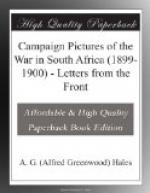The people I am referring to as reivers are farmers recruited by local leaders, and are a particularly dangerous class of people to deal with, as they know every inch of this most deceptive country. As soon as they are whipped they make off to wives and home, and meet the scouts with a bland smile and outstretched hand. It is no use trying to get any information out of them, for no man living can look so much like an unmitigated fool when he wants to as the ordinary, every-day farmer of the veldt. I know Chinamen exceptionally well, I have had an education in the ways of the children of Confucius; but no Chinaman that I have come in contact with could ever imitate the half-idiotic smile, the patient, ox-like placidity of countenance, the meek, religious look of holy resignation to the will of Providence which comes naturally to the ordinary Boer farmer. It is this faculty which made our very clever Army Intelligence people rank the farmer of the veldt as a fool. Yet, if I am any judge, and I have known men in many lands, our friend of the veldt is as clever and as crafty as any Oriental I have yet mixed with.
Now for the Australian fight. On the day before Christmas, Colonel Pilcher, at Belmont, got wind of the assemblage of a considerable Boer force at a place 30 miles away, called Sunnyside Farm, and he determined to try to attack it before the enemy could get wind of his intention. To this end he secured every nigger for some miles around—which proved his good sense, as the niggers are all in the pay of the Boers, no matter how loyal they may pretend to be to the British, a fact which the British would do well to take heed of, for it has cost them pretty dearly already. On Christmas Eve he started out, taking two guns of the Royal Navy Artillery, a couple of Maxims, all the Queenslanders, and a few hundred Canadians. Colonel Pilcher’s force numbered in all about 600 men. He marched swiftly all night, and got to Sunnyside Farm in good time Christmas Day. The Boers had not a ghost of an idea that our men were near them, and were completely beaten at their own game, the surprise party being complete. The enemy were found in a laager in a strong position in some rather steep kopjes, and it was at once evident that they were expecting strong reinforcements from surrounding farms. Colonel Pilcher at once extended his forces so as to try to surround the kopjes. Whilst this was going on, Lieutenant Aide, with four Queensland troopers, was sent to the far left of what was supposed to be the Boer position. His orders were to give notice of any attempt at retreat on the part of the enemy. He did his work well. Getting close to the kopje, he saw a number of the enemy slinking off, and at once challenged them. As he did so a dozen Boers dashed out of the kopje, and Aide opened fire on them, which caused the Boers to fire a volley at him. Lieutenant Aide fell from his horse with two bullets in his body; one went through the fleshy part of his stomach, entering his body sideways, the other went into his thigh. A trooper named McLeod was shot through the heart, and fell dead. Both the other troopers were wounded. Trooper Rose caught a horse, and hoisted his lieutenant into the saddle, and sent him out of danger.




